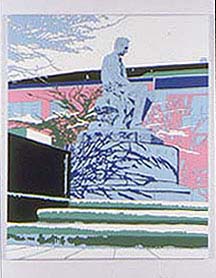Lisa Ruyter at Mitchell Algus Gallery and Rove/Kenny Schachter*
by Odili Donald Odita
 |
Lisa Ruyter
"Germany in Autumn," 1998
Acrylic on Canvas |
*To be published in Flash Art International, January/February, 1999. Lisa Ruyter's paintings are unlike those of many of her contemporaries that often speak from the unenlightened position of privilege. Ms. Ruyter boldly brings to question her position as a member of a mainstream America drowning in its overwhelming materialist and consumerist value system. The fact that the artist is so clearly able to contemplate the burgeoning weight and residue of prosperity within the American landscape is an accomplishment all unto itself. The most poignant point Ruyter makes in the extremely ambitious exhibitions she held concurrently last spring at Kenny Schachter's Rove Gallery and the Mitchell Algus Gallery was the lack of any evident social cohesion between the figures and objects depicted. Whether the pictured be leaf-less trees shading idyllic suburban houses, or the abandoned boats on still lake shores, the left over feeling became all the same- loneliness and isolation within the American Ideal. What one gets from Ms. Ruyter's paintings are signs of breakdown, both materialistic and psychological. Ruyter conveys these points most directly in the painting 'Germany in Autumn' (1998). The painting centers on the ice-blue statue of Abraham Lincoln, which is depicted in what looks to be a bitterly cold environment. The statue's hands sit extended between his legs as if this were the most immediate place to keep them warm. The cast shadows of the branches onto the statue's base are painted as violent lacerations dripping blue-blood. The painting culminates with an open painted area of white that surrounds this figure's head and reinforces the overpowering sad quality of silence. Soft, cool pink paint in the background compliments the sub-zero temperature of this painting. Lisa Ruyter is a figurative painter that pushes the painting's reality nearly to a point of pure abstraction in her application of high-keyed color outlined with a fine tipped black marker. Ruyter's color becomes the blazing neon of a nuclear fall-out; one that has destroyed the family, the nucleus of house and home. What remains in her pictures are the objects that make up the materialist reality of the suburban. Like the film, 'Dawn of the Dead', we wait for the living dead to come out and eat all else that moves. Unfortunately, the story this artist so convincingly paints to is one that most Americans live through everyday, whatever their social status. Only with the kind of criticality employed by Ms. Ruyter can there begin to be a change in the way we all think about ourselves in the world around us.
Copyright ©1998 PLEXUS Art and Communication & the Authors All Rights Reserved
|